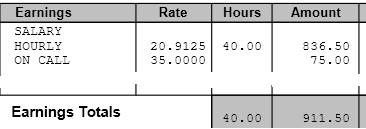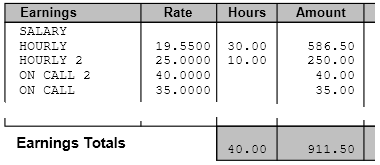
List Two Pay Rates on a Paycheck
When paychecks and direct deposit stubs print, earnings for an earning code are combined on one line on the stub. This can lead to an average rate being displayed rather than the actual rates.
For Example if Employee A was paid the following:
| Earning Code | Rate | Hours | Earnings |
| HR | 19.55 | 30.00 | 586.50 |
| HR | 25.00 | 10.00 | 250.00 |
| ONCL | 35.00 | 0 | 35.00 |
| ONCL | 40.00 | 0 | 40.00 |
| Totals | 40.00 | 911.50 |
HR = hourly rate, ONCL = On Call salary amount
The paystub will print as shown below. The hourly rate will combine as one total and calculate an "effective" average hourly rate of 20.9125 for 40 hours. The salary On Call amounts will also combine showing the first salary rate and the total paid.

To have the rates shown separately on the paystub, different earning codes can be setup and used. See How to Setup a New Earning Code for instructions.
For Example:
| Earning Code | Rate | Hours | Earnings |
| HR | 19.55 | 30.00 | 586.50 |
| HR2 | 25.00 | 10.00 | 250.00 |
| ONCL | 35.00 | 0 | 35.00 |
| ONCL | 40.00 | 0 | 40.00 |
| Totals | 40.00 | 911.50 |
The earning codes will now print on separate lines on the paystub showing the actual rates used for each code.

 WARNING: Entering too many unique codes can fill up the allowable space on the paystub. The number of lines allowed may vary based on the Check Format used. Once the allowable space is used, the stub will list all additional earnings as "All Others".
WARNING: Entering too many unique codes can fill up the allowable space on the paystub. The number of lines allowed may vary based on the Check Format used. Once the allowable space is used, the stub will list all additional earnings as "All Others".
12/2023